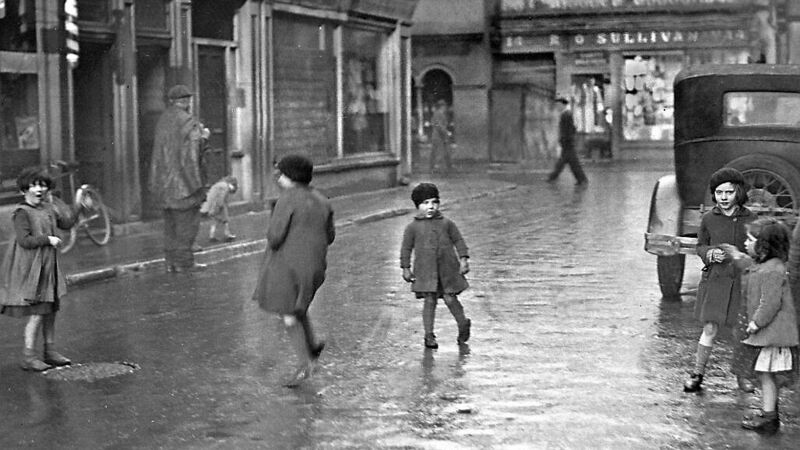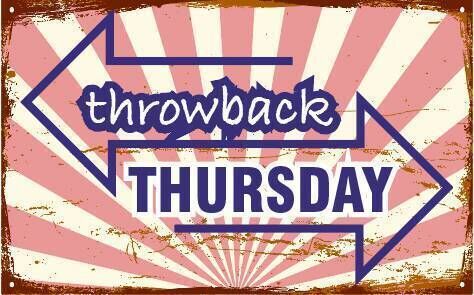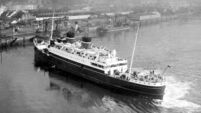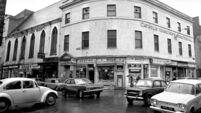Throwback Thursday: Childhood in Cork, when we had jumpers for hurling goalposts

After we ran this photo of children playing with a skipping rope on Adelaide Street, Cork city, in 1937, last week in Throwback Thursday, a reader got in touch to name some of the businesses seen here.
WE had such a delightful response to Mícheál Kenefick’s memories of childhood games in last week’s Throwback Thursday, that we are pleased to be able to offer some more of his recollections of growing up in Whitegate:
“Unusually, we played cricket now and then in the summer, and played over by the bog,” he said. “We had proper gear once, but normally we made the stumps and bails ourselves and the hurley found another use as a bat.
Regardless of what we didn’t have, we were never without a hurley and a ball.
“As an aside, Mick Reilly and myself used to listen to cricket on the wireless in the 1950s.”
Micheál continues: “The hurling pitches were in Day’s Wood, which was a natural amphitheatre, and in Hartnett’s field. There were three trees perfectly placed in Day’s so we only needed one jumper or coat or school sack as the fourth goalpost, but as Hartnett’s Field had no trees, we had to use four jumpers or coats as posts, thereby quadrupling the arguments in disputing whether it was a goal or over the coat.

‘No goal - twas over the coat’. Even if it happened to be a sack or a jumper, we always called it ‘over the coat’.”
“We often played hurling and that wonderful game, rounders, on the street, and would only rarely have to stand aside to let a car pass. Just try it now!” points out Micheál.
“Road bowling was very popular for a few years, particularly during the construction of the Refinery, and there would be hundreds of people at scores on the School Road in the summer evenings and on Sundays after second Mass.
We used to play after school too, but we had no real interest and that fad for us didn’t last long.
Micheál says he never played Gaelic Football with his friends, “but we did play soccer with plastic footballs - a tanner a man until we had five shillings - up the Boreen by Kelly’s garage and in the village by the gate at the Middle pier or the Coalstore.

“We swam every day in the Sawmills - rain or shine - and went to White Bay at the weekend.
“We had a mini Pitch and Putt course, also in the Sawmills, and we had to be quite skilful as we were surrounded by water on three sides and a lost ball meant game over as the nearest sports shop was in Cork.”
Micheál adds: I often think that if we had had access to a golf club, some of us might have been quite good, but for us to get into a golf club in those days was like asking Michael Collins (the other one) to pick us up in the Sawmills on his way to the Moon a decade later!”
The memories of childhood keep on coming from Micheál.
“We spent endless hours before we had bicycles, pushing bicycle wheels at speed around the village with a stick. The best ones were spokeless and tireless.
“We never walked when playing with those wheels, always ran, so we were always fit!”
Activities had a seasonal hue as well.
“Come the autumn, we would knock a few weeks out of the conkers,” said Micheál. “The tree by the club is still laden today.
“Some of the wise boys would always have one from last season, which would have spent some time up the chimney, and would smash the current crop to smithereens.
“We also played Four Corner Fool and Tig -‘You’re it!’ - in the school yard as a confined space was required, and finally the two most ridiculous games known to mankind - Giant Steps and ‘1 2 3 the Book Is Read’: Jimmy O’Leary: two Giant Steps’, and in the same breath - ‘Backwards’. ‘Teresa Bennett: three Baby Steps...’”
Is ‘1, 2, 3, The Book Is Read’ that game where one person faces a wall with their face covered by their hands, while the rest of the players try to advance cautiously behind them to touch the wall?
If so, the trick was to say the phrase very fast or very slow, and then whip around to catch someone in mid-movement. As this writer recalls, nobody ever made it to that wall, even though many would do their best not to be eliminated by standing in a wobbly one-legged position when the watcher whipped round!

But back to Mícheál Kenefick, and the things he and his friends did to pack every minute of every day.
“All in their due season, we picked spuds and periwinkles for pocket money, or did without. And we never missed the Devotions in May and October.
“Add in the Regatta, and at least a month to prepare for the Bonfire, so without a mobile (we wouldn’t even have a land line for another 20 years), Nintendo, television or computer, we hadn’t a second to spare, and were never bored.
As a slight aside, one thing I did see recently while abroad was a ‘playground’ for Senior Citizens - what a wonderful idea!
Thank-you for remembering all those games and pastimes for us, Mícheál! Do they ring bells with other readers? Or are there some you could add? Let us know.
Meanwhile, Fintan Bloss was entranced to see the picture last week of children skipping in Adelaide Street in the 1930s, especially as he was able to identify many of the premises shown in the photo.
“Hi, Jo. That 1937 photo of Adelaide Street featured O’Brien’s hairdressers, where I had my first short back and sides in the 1960s. I hated that short back and sides and moved on to the long hair as soon as I could, in the 1970s.
“Mike Moynihan’s Heads Only was the hairdresser of the day on Paul Street. He was a big fan of The Average White Band, and Pick Up The Pieces was a big hit of the time.”
It was indeed, Fintan. That Scottish funk and R&B band had a whole series of soul and disco hits between 1974 and 1980, but are perhaps best known for their million-selling instrumental track, Pick Up the Pieces. Clearly, Mr Moynihan had taste!
“A member of the O’Brien family still resides in Adelaide Street,” continues Mr Bloss, “and I meet Mike Moynihan about once a year for a catch-up on a time gone by.”
Back to that 1937 photo.
“R. O’Sullivan, Drapers, is in the background of that picture at 14 North Main Street,” said Fintan. “I remember that, at 13, North Main Street, was John Daly and Co Ltd of Tanora fame, and at 15/16 North Main Street were Cork Iron and Hardware Ltd.”
Ah, the shops of yesteryear. Are there any left? Perhaps Leaders is one of the last?
Fintan was inspired by the kids skipping to recall some of the old chants familiar from childhood street games.
“Maybe they were chanting ‘The rip, the rap, the sailor broke his back, slipped on a banana skin and that was that!’” he suggests.
Now, the version Katie O’Brien remembers from her own skipping days is a little less violent, and extends further:
“The rick, the rack, the sailor on the sea,
Please take a loop from me.
Are you coming, are you coming, are you coming to the fair?
I went and I went but the fair wasn’t there.
But - sure- I - must - not - miss - a - loop - now.”
When pressed, Katie cannot quite remember what gymnastics were required for that last line, but thinks it probably involved running in and out of the moving rope - quite a demanding feat.
Another reader, Tim Cagney, was interested to read about our discussion of Mutton Lane, that narrow alleyway leading into the English Market, and containing what is claimed to be the oldest pub in the city outside North and South Main Street. (Is the oldest the Oval then? Somebody please tell us!)
My father was raised at a place called Cattle Market Street - later changed to Glen Ryan Road,” explains Tim.
“I know very little about my father’s side of the family, but have reason to believe his own father was involved in the meat trade. I have heard whispers of abattoirs being located in that area.
Could this be where the original name of the street came from?
Well, the lower streets on the Northside, down from the North Cathedral into Blackpool, were always known for their abattoirs, Tim. Lunhams and Denny’s were just two, and readers can probably remember more.
Then, of course, there was Evergreen on the southside. We were, after all, a major producer of meat for both home consumption and export.
If you have read that wonderful book by Noel Magnier, Is That You, Boy!, you will remember that he earned his pocket money in a 1950s childhood by cleaning out the trucks and lorries which shipped the hapless pigs, sheep and cattle to Denny’s cellar in Hodder’s Lane, off Gerald Griffin Street.
“It was a huge complex which employed hundreds of men and women, all from around the Northside,” wrote Noel. “Denny’s meats and sausages were famous all over Ireland and abroad, but for people who lived in the vicinity, it was that smell they all remembered…
“The nuns in the convent were constantly complaining to the management, and appealing to the Gardaí on the Watercourse Road was futile, as they had to suffer the smell also.”
Anybody who hasn’t got a copy of Noel’s delightful book of growing up on the northside, go out and find it now! Essential reading for anybody who loves our city - and who doesn’t?
And on the query of how Cattle Market Street got its name, Tim, well, there was certainly a livestock market up there back in the day. And Old Market Place off Blarney Street still holds its memories of being a bustling place for vendors on specific days of the week, even though it is now almost entirely residential.
There is, we think, a plaque on the wall a little way up Barrack Street on the southside too, commemorating where a market was once held. So many local places where you could do your shopping back then!
“By the way,” adds Tim finally, “that was a wonderful image last week of those four kids, tucking-into their ice-cream wafers. I could well have been one of them - I was six in 1954.”
Ah, nothing like the wafer. Today’s shrink-wrapped processed products are not the same thing at all.
Is there anywhere you can still get a wafer? It used to be possible at the little shop by the beach in Fountainstown - anybody been down lately? That lovely lady in charge would cut extra big ones and keep them in the chiller until the crowds arrived.
And that mention of wafers, an essential accompaniment to an Irish summer, reminds us - now listen up!
We want to make this wonderful month of June a time for remembering those halcyon summer days of yore, when you went on your holidays to the seaside, maybe took an unforgettable excursion train to Youghal, or a bus to Crosshaven, or even got driven further afield to faraway places only just coming into vogue like Barley Cove.
Did you brush up your Irish somewhere like Cape Clear? If there are any memories in your mind today, as you look at the blue skies and sniff the summer air, of long-ago buckets and spades, sand between your toes, of Going Home or Staying Down, even of Ford Box bungalows, then let us know!
Over the next two Throwback Thursdays we will be giving special attention to recollections of those happy times by the sea as part of our Cork Coasts series.
Everybody, it is said, has one special day in their memory - one day when everything was perfect, never to be repeated. For most of us, that was on a summer’s day.
Let’s hear from you! Email jokerrigan1@gmail.com or leave a message on our Facebook page: https://www.facebook.com/echolivecork.







